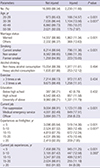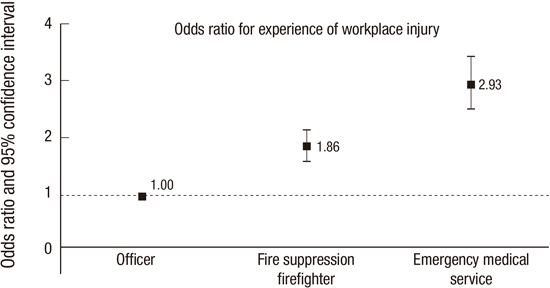1. Matt SE, Shupp JW, Carter EA, Flanagan KE, Jordan MH. When a hero becomes a patient: firefighter burn injuries in the National Burn Repository. J Burn Care Res. 2012; 33:147–151.
2. Spadafora R. Firefighter safety and health issues at the World Trade Center site. Am J Ind Med. 2002; 42:532–538.
3. Kim MG, Kim KS, Ryoo JH, Yoo SW. Relationship between occupational stress and work-related musculoskeletal disorders in Korean male firefighters. Ann Occup Environ Med. 2013; 25:9.
4. Khanzode VV, Maiti J, Ray PK. Occupational injury and accident research: a comprehensive review. Saf Sci. 2012; 50:1355–1367.
5. Houser AN, Jackson BA, Bartis JT, Peterson DJ. Emergency Responder Injuries and Fatalities: an Analysis of Surveillance Data. Santa Monica, CA: RAND Science and Technology;2004.
6. Haynes HJ, Molis JL. US Firefighter Injuries in 2014. Quincy, MA: National Fire Protection Association;2015.
7. Reichard AA, Jackson LL. Occupational injuries among emergency responders. Am J Ind Med. 2010; 53:1–11.
8. Maguire BJ, Hunting KL, Guidotti TL, Smith GS. Occupational injuries among emergency medical services personnel. Prehosp Emerg Care. 2005; 9:405–411.
9. Ahn Y, Hyun S, Jeong K, Kim K, Choi K, Chae J. The Analysis of Risk Factors Related Health and Safety at Disasters and Development of Special Medical Health Examination System for Firefighters. Seoul: Korea National Emergency Management Agency;2011.
10. National Institute of Standards and Technology (US). The Economic Consequences of Firefighter Injuries and Their Prevention. Final Report. Arlington, VA: National Institute of Standards and Technology;2004.
11. Cohen GR, Yang SY. Mid-P confidence intervals for the Poisson expectation. Stat Med. 1994; 13:2189–2203.
12. Szubert Z, Sobala W. Work-related injuries among firefighters: sites and circumstances of their occurrence. Int J Occup Med Environ Health. 2002; 15:49–55.
13. Jahnke SA, Poston WS, Haddock CK, Jitnarin N. Injury among a population based sample of career firefighters in the central USA. Inj Prev. 2013; 19:393–398.
14. Taylor NA, Dodd MJ, Taylor EA, Donohoe AM. A retrospective evaluation of injuries to Australian urban firefighters (2003 to 2012): injury types, locations, and causal mechanisms. J Occup Environ Med. 2015; 57:757–764.
15. Cantley LF, Galusha D, Cullen MR, Dixon-Ernst C, Rabinowitz PM, Neitzel RL. Association between ambient noise exposure, hearing acuity, and risk of acute occupational injury. Scand J Work Environ Health. 2015; 41:75–83.
16. Yoon JH, Hong JS, Roh J, Kim CN, Won JU. Dose - response relationship between noise exposure and the risk of occupational injury. Noise Health. 2015; 17:43–47.
17. Cantley LF, Galusha D, Cullen MR, Dixon-Ernst C, Tessier-Sherman B, Slade MD, Rabinowitz PM, Neitzel RL. Does tinnitus, hearing asymmetry, or hearing loss predispose to occupational injury risk? Int J Audiol. 2015; 54:Suppl 1. S30–6.
18. Hong O, Samo D, Hulea R, Eakin B. Perception and attitudes of firefighters on noise exposure and hearing loss. J Occup Environ Hyg. 2008; 5:210–215.
19. Islam SS, Velilla AM, Doyle EJ, Ducatman AM. Gender differences in work-related injury/illness: analysis of workers compensation claims. Am J Ind Med. 2001; 39:84–91.
20. Saleh SS, Fuortes L, Vaughn T, Bauer EP. Epidemiology of occupational injuries and illnesses in a university population: a focus on age and gender differences. Am J Ind Med. 2001; 39:581–586.
21. Benavides FG, Benach J, Muntaner C, Delclos GL, Catot N, Amable M. Associations between temporary employment and occupational injury: what are the mechanisms? Occup Environ Med. 2006; 63:416–421.
22. Craig BN, Congleton JJ, Kerk CJ, Amendola AA, Gaines WG. Personal and non-occupational risk factors and occupational injury/illness. Am J Ind Med. 2006; 49:249–260.
23. Veazie MA, Smith GS. Heavy drinking, alcohol dependence, and injuries at work among young workers in the United States labor force. Alcohol Clin Exp Res. 2000; 24:1811–1819.
24. Ryan J, Zwerling C, Orav EJ. Occupational risks associated with cigarette smoking: a prospective study. Am J Public Health. 1992; 82:29–32.
25. Britton C, Lynch CF, Torner J, Peek-Asa C. Fire characteristics associated with firefighter injury on large federal wildland fires. Ann Epidemiol. 2013; 23:37–42.








 PDF
PDF ePub
ePub Citation
Citation Print
Print





 XML Download
XML Download